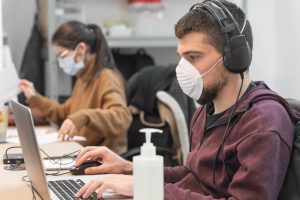As the number of COVID-19 cases continues to rise in the U.S., the Centers for Disease Control and Prevention (CDC) this week recommended that fully vaccinated people wear masks indoors in substantial or high-transmission areas. This is an about turn from the agency’s May guidance, which said it was safe for fully vaccinated people to stop wearing masks in most settings.
However, as the number of vaccinations began to slow and the Delta variant of COVID-19 began to take hold in the U.S., the number of new COVID cases, hospitalizations, and deaths started to creep upward.
As a result, the CDC now says fully vaccinated people should wear a mask in public indoor settings if they are in “an area of substantial or high transmission.” According to the CDC’s COVID Data Tracker, two-thirds of U.S. counties fall into the substantial or high transmission categories; 50% of counties are considered high transmission, up 18% from a week ago.
“Risk of SARS-CoV-2 infection, severe disease, and death is reduced for fully vaccinated people. Though they happen in only a small proportion of people who are fully vaccinated, some infections do occur among fully vaccinated people. Fully vaccinated people who do become infected with the Delta variant can transmit it to others,” according to the CDC guidance. “Therefore, fully vaccinated people can further reduce their risk of becoming infected with the Delta variant and transmitting it to others by wearing a mask in public indoor settings in areas of substantial or high community transmission. Wearing a mask in public is most important for people who are immunocompromised.”
The CDC’s guidance also noted that fully vaccinated people should also continue to wear a mask where required by federal, state, local, tribal, or territorial laws, rules, and regulations—including local business and workplace guidance—as well as in prisons and homeless shelters. Prevention measures are still recommended for unvaccinated people.
In addition, the CDC recommends that fully vaccinated people get tested if they experience COVID-19 symptoms and isolate if they have tested positive for COVID-19 in the prior 10 days or are experiencing symptoms. Vaccinated people should get tested three to five days after exposure to someone with suspected or confirmed COVID-19 and wear a mask in public indoor settings for 14 days after exposure or until they receive a negative test result.
The revised guidance will force businesses to reconsider their policies; large retailers such as Walmart and Publix removed mask requirements for vaccinated shoppers in their stores following the May CDC guidance.
Vaccination against COVID-19 is an effective way to prevent serious illness, hospitalization, and death, but at this point, the CDC reports that only 49.3% of Americans are fully vaccinated and 57.1% have received at least one dose of a COVID vaccine.
Devjani H. Mishra, a leader of Littler’s COVID-19 Task Force and Return-to-Work Team, recommends that employers look at the different guidance that exists for their state and region. Mishra says employers also need to understand their workforce, whether employees or non-employees, and the risks involved as they consider their next steps.
“Employers should be looking to establish good exposure control plans that take into account all these factors: Who in the workforce is vaccinated, how do people work, are they able to maintain separation if they’re unvaccinated, are they able to continue wearing masks if they’re unvaccinated?” Mishra says. “In some cases with the new CDC guidance, they may have to revisit wearing masks even if [workers] are fully vaccinated. But really, there’s no substitute for an employer knowing the particular risks in their workplace, based on the way people are working, based on the way people are coming and going and for a lot of employers frankly this may cause them to reconsider whether they’re bringing as many people back into the workplace.”
Look for the entire interview with Mishra in an upcoming episode of the EHS on Tap podcast.

